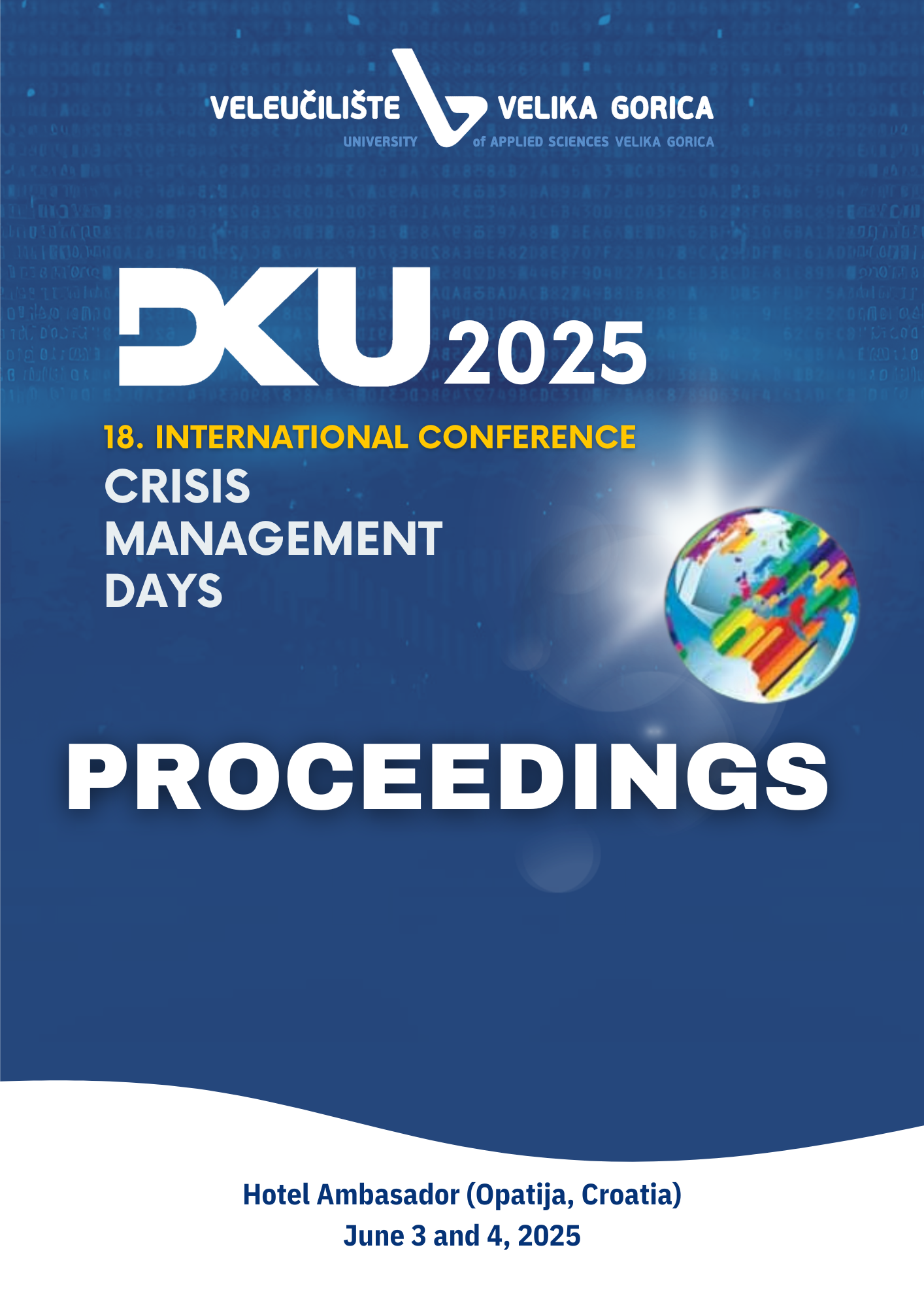Published 2025-11-27
Keywords
- AMOK,
- hybrid public place,
- threat,
- violence,
- police tactics
How to Cite
Copyright (c) 2025 Damir Pišković, Davor Solomun, Marijan Jozić

This work is licensed under a Creative Commons Attribution-ShareAlike 4.0 International License.
Abstract
This paper analyzes and questions the specificities of police tactics in so-called AMOK situations (a state of uncontrollable rage or violence, often associated with senseless destruction or attacks) characterized by extreme violence perpetrated by an individual or group who randomly and uncontrollably endanger the lives and safety of people in selected hybrid (quasi) public spaces. Given their extremely negative implications for citizen, public, and national security, AMOK incidents demand special attention and require police and other security services to engage in systematic monitoring and protocol-based crisis response. These crisis events are sudden and difficult to predict, involving the lethal use of firearms or cold weapons, but recently also various motor vehicles, leading to mass casualties and serious threats to public facilities and spaces In examining the adequacy of response and police tactics in resolving these situations, the crucial variable is the attackers – perpetrators, who typically exhibit psychological difficulties, a sense of social isolation, and motivations related to revenge or personal frustrations, regardless of their social status. At the same time, in certain overlapping aspects of AMOK situations, the attackers may possess a radical ideology that leads toward terrorism. Victims are mostly within hybrid public spaces—students, bystanders, employees, or visitors—where targets may be selected or entirely random. AMOK incidents typically follow several stages: preparatory, execution, intervention, attacker neutralization, and post-crisis. It is important to emphasize that a swift response by potential victims through the "RUN, FIGHT OR HIDE" protocol, along with effective evacuation, is crucial until police arrive. Accordingly, this analysis, in addition to its conceptual and theoretical foundation, includes a case study of ten selected typical AMOK events. The cases are examined using a specially designed methodological model—a matrix of 10–11 variables—through which the patterns and specificities of these events are discussed. In line with the research objective, patterns in the analyzed incidents and responses are identified, and the effectiveness of applied police tactics is assessed, with a view to validating and implementing best practices. The results of the statistical operations confirm a statistically significant correlation between the "speed of police intervention and duration of the attack" (χ²(2) = 9, p = 0.011). In addition to more effectively resolving crisis situations, the research results may also plausibly be applied to the development of preventive tactical measures aimed at enhancing public safety and preventing such events or reducing their harmful consequences.
References
- Amok. (1992/2025). Medicinski leksikon [mrežno izdanje]. Leksikografski zavod Miroslav Krleža. Preuzeto 2. lipnja 2025. s https://medicinski.lzmk.hr/clanak/amok
- Artwohl, A., & Christensen, L. W. (1997). Deadly force encounters: What cops need to know to mentally and physically prepare for and survive a gunfight. Boulder, CO: Paladin Press.
- Artwohl, A., & Christensen, L. W. (2020). Deadly force encounters: Cops & citizens defending themselves and others. [Sine loco]: Independently published.
- BBC News (2015), Charlie Hebdo attack: Three days of terror. https://www.bbc.com/news/world-europe-30708237
- BBC News (2016), Nice attack: What we know about the Bastille Day killings (19.08.2016.) https://www.bbc.com/news/world-europe-36801671
- BBC News (2017), Sandy Hook shootings: Four things revealed by FBI files. https://www.bbc.com/news/world-us-canada-41749336
- BBC News (2019), London Bridge attack: What happened (03.05.2019.)
- https://www.bbc.com/news/uk-england-london-40147164
- BBC News (2023), James Gregory in London & Slobodan Maricic in Belgrade (04.05.2023.) Belgrade shooting: Teen made 'kill list' for Serbia school attack
- https://www.bbc.com/news/world-europe-65468404
- BBC News (2024), Napad u školi u Zagrebu: Sedmogodišnje dete ubijeno, hiljade u protestnoj šetnji (20.12.2024.) https://www.bbc.com/serbian/articles/cj6zne5j0j9o/lat
- Bjørgo, T., & Jupskås, A. R. (2021), Introduction by the Guest Editors of the Special Issue: The Long-Term Impacts of Attacks: The Case of the July 22, 2011 Attacks in Norway. Perspectives on Terrorism, 15(3), 2–13. https://www.jstor.org/stable/27030879
- Blair, J. P., & Schweit, K. W. (2014), A study of active shooter incidents in the United States between 2000 and 2013. Texas State University and Federal Bureau of Investigation, U.S. Department of Justice.
- Butorac, K., & Solomun, D. (2013). Utemeljenost suvremene policijske znanosti i njen doprinos policijskoj praksi. Policija i sigurnost, 22(1, Supplement), 131–155. Preuzeto s https://hrcak.srce.hr/106742
- Congressional Research Service (2013), The September 2013 Terrorist Attack in Kenya: In Brief
- https://www.everycrsreport.com/files/20131114_R43245_2c841aae0d36b7ba0e44b87d2f47d366d6cf7454.pdf
- Everbridge. (2024). Guide to active shooter drills in the workplace. https://www.everbridge.com/blog/guide-to-active-shooter-drills-in-the-workplace/
- FEMA/USA (2018); 1 October After-Action Report. https://www.policinginstitute.org/wp-content/uploads/2018/09/1OctoberAfterActionReport.pdf
- Jozić, M. (2020). Razlike između pripadnika interventne i specijalne policije u morfološkim i motoričkim obilježjima i u uspješnosti gađanja vatrenim oružjem (doktorska disertacija). Kineziološki fakultet, Zagreb.
- Jozić, M., Mendeš, M., Butorac, K., & Solomun, D. (2020). Utjecaj stresnih situacija na policijskog službenika u odnosu na procjenu situacije prilikom uporabe vatrenog oružja. U I.
- Cajner Mraović & M. Kondor-Langer (ur.), Istraživački dani Visoke policijske škole u Zagrebu: Razumijevanje novih sigurnosnih izazova: Zbornik radova (str. 143–160). Zagreb: Visoka policijska škola.
- Klarić, M. (2022). Borba u bliskim i urbanim prostorima (CQB/MOUT) za pripadnike specijalnih snaga: Priručnik za obuku. Zagreb: Ministarstvo obrane Republike Hrvatske, Glavni stožer Oružanih snaga Republike Hrvatske.
- Lesar, D. (2025). Suvremene taktike policijskog postupanja – AMOK (završni rad). Veleučilište kriminalistike i javne sigurnosti. Neobjavljeni rad.
- Miočić, I. (2018). Fleksibilnost studije slučaja: Prednost ili izazov za istraživače? Ljetopis socijalnog rada, 25(2), 175–194.
- O’Toole, M. E. (2000). The school shooter: A threat assessment perspective. Federal Bureau of Investigation. https://www.fbi.gov/file-repository/stats-services-publications-school-shooter-school-shooter
- Stolnik, D., & Jozić, M. (2024). Suvremeni trendovi integralnog policijskog treninga: Force on force training. Zagreb: Ministarstvo unutarnjih poslova, Policijska akademija.
- Šalaj, D., & Šalaj, S. (2011). Kondicijska priprema specijalne policije Republike Hrvatske – Antiteroristička jedinica Lučko. Kondicijski trening, 9(1), 59–70.
- Vocabulary.com. (n.d.). Amok. In Vocabulary.com Dictionary. Retrieved July 3, 2025, from https://www.vocabulary.com/dictionary/amok
- Yin, R. K. (2007). Studija slučaja: Dizajn i metode. Zagreb: Fakultet političkih znanosti Sveučilišta u Zagrebu.

